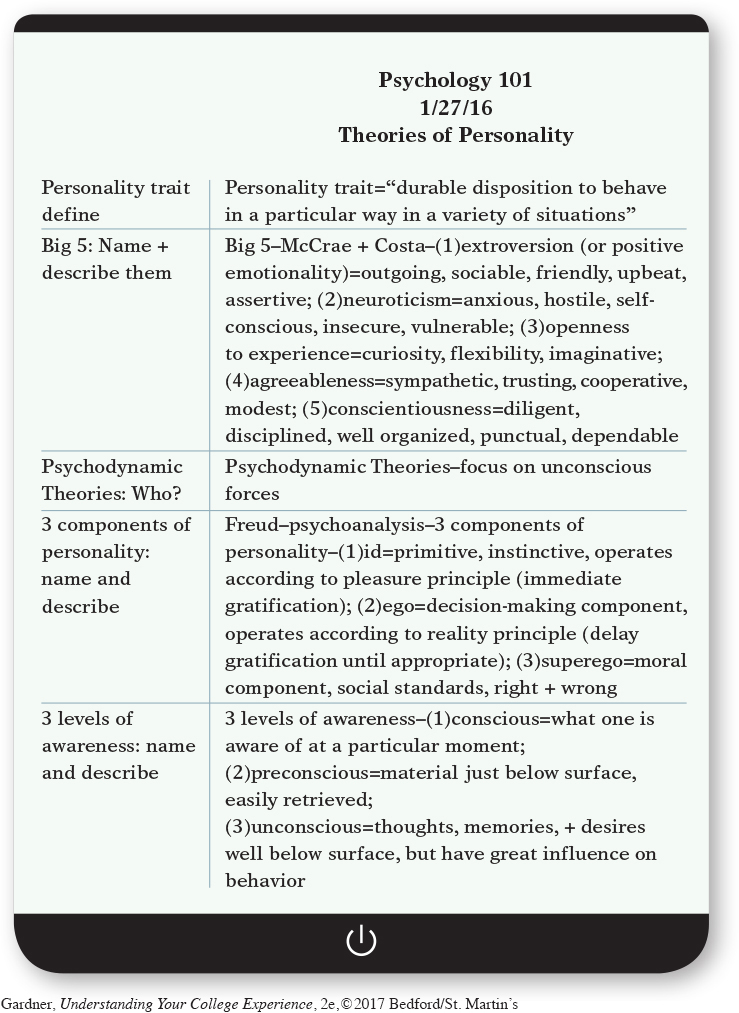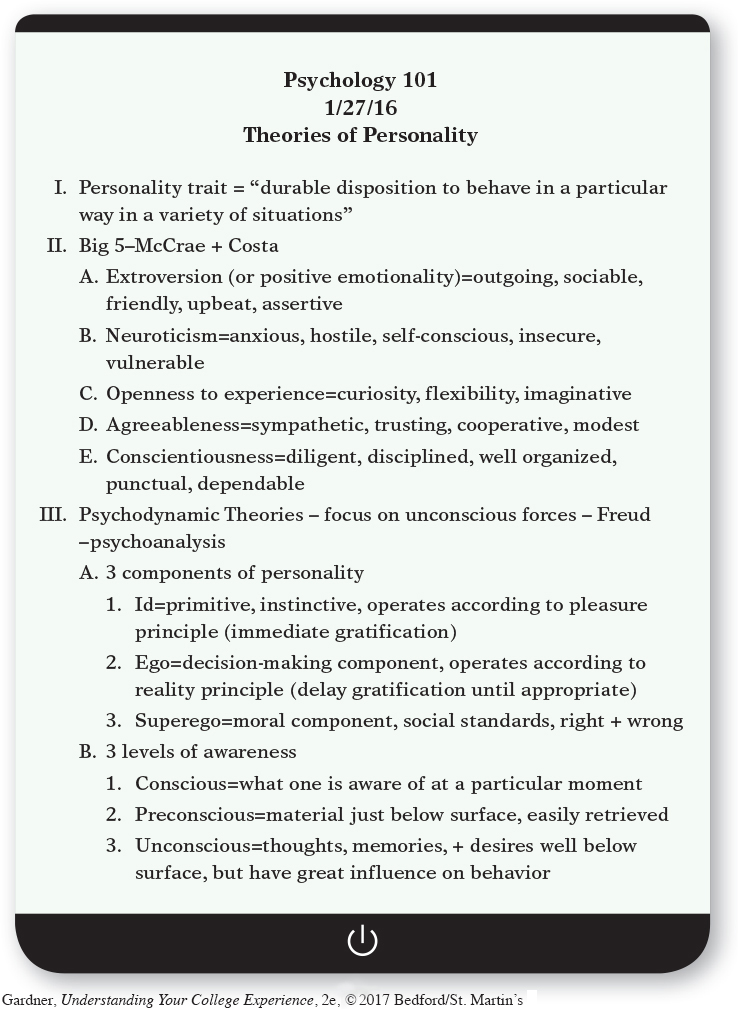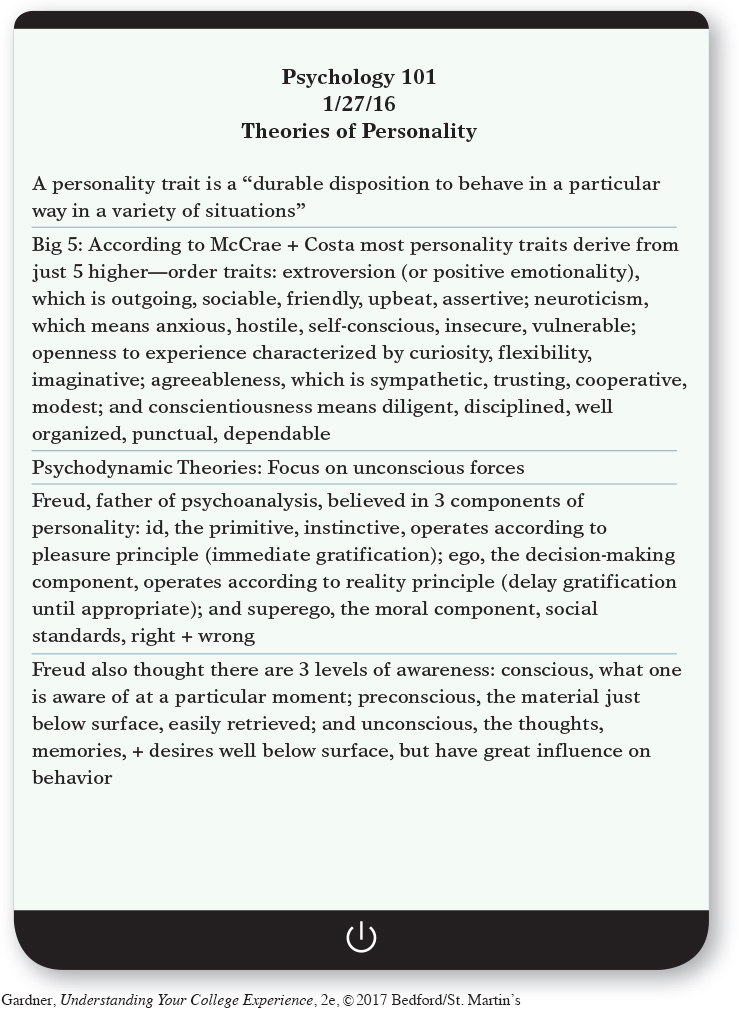5.4 TAKE EFFECTIVE NOTES
What are effective notes? They are notes that cover all the important points of the lecture or reading material without being too detailed or too limited. Most important, effective notes prepare you to do well on quizzes or exams. They also help you understand and remember concepts and facts. Becoming an effective note-taker requires time and practice, but this skill will help you improve your learning and your grades in the first year and beyond.
Note-Taking Formats
You can make class time more productive by using your listening skills to take effective notes, but first you have to decide on one of the following four commonly used formats: Cornell, outline, paragraph, and list formats. Any format can work as long as you use it consistently.
Cornell Format. Using the Cornell format, one of the best-known methods for organizing notes, you create a “recall” column on each page of your notebook or your Word document by drawing a vertical line about two to three inches from the left border or inserting a two-column table (see Figure 5.1). As you take notes during class—whether writing down or typing ideas, making lists, or using an outline or paragraph format—write or type only in the wider column on the right; leave the recall column on the left blank. The recall column is the place where you write down or type the main ideas and important details for tests and examinations as you go through your notes, which you should do as soon after class as possible, preferably within an hour or two. Many students have found the recall column to be an important part of note taking, one that becomes an effective study tool for tests and exams.

YOUR TURN > TRY IT

Use the Cornell format to take notes on this chapter.
Outline Format. Some students find that an outline is the best way for them to organize their notes. In a formal outline, Roman numerals (I, II, III, etc.) mark the main ideas. Other ideas relating to each key idea are marked by uppercase letters (A, B, C, etc.), numbers (1, 2, 3, etc.), and lowercase letters (a, b, c, etc.) in descending order of importance or detail. Using the outline format allows you to add details, definitions, examples, applications, and explanations (see Figure 5.2).

Paragraph Format. When you are taking notes on what you are reading, you might decide to write summary paragraphs—a note-taking format in which you write two or three sentences that sum up a larger section of material (see Figure 5.3). This method might not work well for class notes because it’s difficult to summarize a topic until your instructor has covered it completely. By the end of the lecture, you might have forgotten critical information.

List Format. The list format can be effective in taking notes on terms and definitions, facts, or sequences such as personality types. It is easy to use lists in combination with the Cornell format.

YOUR TURN > TRY IT

Using the list format, review the previous chapter and list the key ideas in your notebook or on a digital device. Add definitions, examples, and other explanations related to each key idea.
Note-Taking Techniques
Whatever note-taking format you choose, follow these important steps:
Identify the main ideas. The first principle of effective note taking is to identify and record the most important ideas in the lecture or reading. Although supporting details are important as well, focus your note taking on the main ideas. Such ideas can be buried in details, statistics, examples, or problems, but you will need to identify and record them for further study. Some instructors announce the purpose of a lecture or offer an outline of main ideas, followed by details. Other instructors develop presentation slides. If your instructor makes such materials available on a course/learning-management system (CMS/LMS) beforehand, you can print them out and take notes on the outline or next to the slides during the lecture. Some instructors change their tone of voice or repeat themselves for each key idea. Some ask questions or provide an opportunity for discussion. If an instructor says something more than once, chances are it is important. Ask yourself, “What does my instructor want me to know at the end of today’s class?”
Don’t try to write down everything. Some first-year students try to do just that. They stop being thinkers and become just note-takers. As you take notes, leave spaces so that you can fill in additional details that you might have missed during class but remember or read about later. Take the time to review and complete your notes as soon after class as possible. Once you have decided on a format for taking notes, you might also want to develop your own system of abbreviations. For example, you might write “inst” instead of “institution” or “eval” instead of “evaluation.” Just make sure you will be able to understand your abbreviations when it’s time to review.
Don’t be thrown by a disorganized lecturer. When a lecture is disorganized, it’s your job to try to organize what is said into general and specific points. When information is missing, you will need to indicate in your notes where the gaps are. After the lecture, review the reading material or ask your classmates to fill in these gaps, or ask your instructor. Some instructors have regular office hours for student appointments while others are willing to spend time after each class session to answer students’ questions. The questions you ask might help your instructor realize which parts of the lecture need more attention or repetition. If your college offers what is known as “Supplemental Instruction” (SI), go for it—it is voluntary, and students who participate do earn better grades. In the SI session, you get the opportunity to share with the SI leader the concepts you did NOT understand in that week’s class; in turn, the SI leader reports that information to the instructor, who will hopefully provide additional explanation in the next class meeting.
Keep your notes and supplementary materials for each course separate. Whether you use folders, binders, or some combination, label your materials with the course number and name. Before class, label and date the paper you will be using for taking notes; after class, organize your notes chronologically. In your folder or binder, create separate tabbed sections for homework, lab assignments, graded and returned tests, and other materials. If you take notes on a digital device, you should create separate files and folders with specific names and dates. You can create a course folder and add subfolders for notes, assignments, and projects within each folder for that course.
Download online notes, outlines or diagrams, charts, and graphs from the CMS/LMS site and bring them to class. You might be able to save yourself a lot of time during class if you do not have to try to copy graphs and diagrams while the instructor is talking. Instead, you can focus on the ideas being presented while adding your own labels and notes.
If handouts are distributed in class, label them and place them near your notes. Add handouts to your binder or folder as you review your notes each day.
Taking Notes in Online Courses. When you are taking an online course, note taking becomes an essential activity because you need to summarize the reading material and put it in your own words, record your ideas and thoughts for online discussions, or keep track of the questions you may have to e-mail your instructor or your classmates at a later time.
Taking Notes in Nonlecture Courses. Always be ready to change your note-taking methods based on the situation. Group discussion is a popular way to teach in college because it engages students in active participation. On your campus you might also have courses with opportunities outside class to discuss the information covered in class.
How do you keep a record of what’s happening in such classes? Assume you are taking notes in a problem-solving group assignment. You would begin your notes by asking yourself, “What is the problem?” and writing down the answer. As the discussion continues, you would list the solutions that are offered. These would be your main ideas. The important details might include the positive and negative aspects of each view or solution. The important thing to remember when taking notes in nonlecture courses is that you need to record the information presented by your classmates as well as by the instructor and to consider all reasonable ideas, even those that differ from your own. Make sure though that you designate in your notes what are the ideas of your instructor versus those of fellow students.
When a course has separate lecture and discussion sessions, you will need to understand how the discussion sessions relate to and add to the lectures. If the material covered in the discussion session is different from what was covered in the lecture, you might need to ask for help in organizing your notes. When similar topics are covered, you can combine your notes so that you have full coverage of each topic.
How to organize the notes you take in a class discussion depends on the purpose or form of the discussion. It usually makes good sense to begin with the list of issues or topics of the discussion. Another approach is to list the questions raised for discussion. If the discussion explores reasons for and against a particular argument, divide your notes into columns or sections for each set of reasons. When different views are presented in discussion, record all the ideas. Your instructor might ask you to compare your own opinions to those of other students and explain why and how you formed those opinions.
Taking Notes in Mathematics and Science Courses. Many mathematics and science courses build on one another from term to term and from year to year. When you take notes in one of these courses, you will likely need to go back to those notes in a future course. For example, when taking organic chemistry, you might need to review the notes you took in earlier chemistry courses. This can be particularly important if some time has passed since you completed your last related course, such as after a summer or a winter break.
Taking notes in math and science courses can be different from taking notes in other classes. The following tips can help:
Write down any equations, formulas, diagrams, charts, graphs, and definitions that the instructor puts on the board or screen.
Write the instructor’s words as precisely as possible. Technical terms often have exact meanings and cannot be changed.
Use standard symbols, abbreviations, and scientific notation.
Write down all worked problems and examples step-by-step. The steps are often necessary in answering exam questions. Actively engage in solving the problem yourself as it is being solved at the front of the class. Be sure that you can follow the logic and understand the sequence of steps. If you have questions you cannot ask during lecture, write them down in your notes so that you can ask them in discussion, in the lab, or during the instructor’s office hours.
Consider taking your notes in pencil or erasable pen. You might need to make changes if you are copying long equations while also trying to pay attention to the instructor. You want to keep your notes as neat as possible. Later, you can use colored ink to add other details.
Listen carefully to other students’ questions and the instructor’s answers. Take notes on the discussion and during question-and-answer periods.
Use asterisks, exclamation points, question marks, or symbols of your own to highlight important points in your notes or questions that you need to come back to when you review.
Refer back to the textbook after class; the text might contain better diagrams and other visual representations than you can draw while taking notes in class. If they are not provided in handouts or on the CMS, you might even want to scan or photocopy diagrams from the text and include them with your notes in your binder.
Keep your binders for math and science courses until you graduate. They will serve as good review materials for later classes in math and science. In some cases, these notes can also be helpful in the workplace.
Using Technology to Take Notes. While some students use laptops, tablets, or other mobile devices for note taking (see the Tech Tip in this chapter), others prefer taking notes by hand so that they can easily circle important items or copy equations or diagrams while they are being presented. If you handwrite your notes, typing them after class for review purposes might be helpful, especially if you are a kinesthetic learner, preferring to learn through experience and practice. After class you can also cut and paste diagrams and other visuals into your notes and print a copy that might be easier to read than notes you wrote by hand.
Some students—especially aural learners, who prefer to hear information—find it advantageous to record lectures. Try an app like QuickVoice Recorder, Voice Recorder, or Super Notes. But if you record, don’t become passive; listen actively. Students with specific types of learning disabilities might be urged to record lectures or use the services of note-takers, who type on a laptop while the student views the notes on a separate screen.
YOUR TURN > DISCUSS IN CLASS

Use the following table to list the advantages and disadvantages of taking notes on a mobile device and by hand, and be prepared to discuss your ideas in class.
| Typing notes on a mobile device | Handwriting notes on paper | ||
| Advantages | Disadvantages | Advantages | Disadvantages |
Review Your Notes
Unless we take steps to remember it, we forget much of the information we receive within the first 24 hours; in fact, the decline of memory over time is known as the forgetting curve. So if you do not review your notes almost immediately after class, it can be difficult to remember the material later. In two weeks, you will have forgotten up to 70 percent of it! Forgetting can be a serious problem when you are expected to learn and remember many different facts, figures, concepts, and relationships for a number of classes.
Immediate reviewing will help your overall understanding as well as your ability to remember important details during exams. Use the following three strategies:
Write down the main ideas. For five or ten minutes, quickly review your notes and select key words or phrases. Fill in the details you still remember but missed writing down. You might also want to ask your instructor or a classmate to quickly look at your notes to see if you have covered the major ideas.
Repeat your ideas out loud. Repeat a brief version of what you learned from the class either to yourself or to someone else. For many, the best way to learn something is to teach it to others. You will understand something better and remember it longer if you try to explain it to someone else such as your kids, your coworker, or a classmate. This helps you discover your own reactions and find the gaps in your understanding of the material. Asking and answering questions in class can also provide you with the feedback you need to make certain your understanding is accurate.
Review your notes from the previous class just before the next class session. As you sit in class the next time it meets, waiting for the instructor to begin, use the time to quickly review your notes from the previous class session. This will prepare you for the lecture that is about to begin and help you to ask questions about material from the earlier lecture that might not have been clear to you.
What if you have three classes in a row and no time for studying between them? Repeat the information as soon after class as possible. Review the most recent class first. Never delay doing this; if you do, it will take you longer to review, select main ideas, and repeat the ideas. With practice, you can complete the review of your main ideas from your notes quickly, perhaps between classes, during lunch, or while waiting for or riding the bus.
Compare Notes
Comparing notes with other students in a study group, online course, SI session, or learning community has a number of benefits. You will probably take better notes when you know that
someone else will be looking at them,
you will have a chance to see whether your notes are as clear and organized as those of other students, and
you will be able to assess whether you agree on the most important points.
Take turns testing each other on what you have learned. This will help you predict exam questions and find out if you can answer them. In addition to sharing specific information from the class, you can also share with one another how you take and organize your notes. You might get new ideas that will help your overall learning.
Be aware, however, that merely copying another student’s notes, no matter how good those notes are, does not benefit you as much as comparing notes does. If you had to be absent from a class because of illness or a family emergency, it’s fine to ask for another student’s notes to see what you missed, but just rewriting those notes might not help you learn the material. Instead, summarize the other student’s notes in your own words so that you know you understand the important points.
Class Notes and Homework
Once you have reviewed your notes, you can use them to complete homework assignments. Follow these steps:
Do a warm-up for your homework. Before doing the assignment, look through your notes again. Use a separate sheet of paper to rework examples, problems, or exercises. If there is related assigned material in the textbook, review it. Go back to the examples. Cover any answers or solutions, and try to respond to the questions or complete the problems without looking. Keep in mind that it can help to go back through your course notes, reorganize them, highlight the important items, and create new notes that let you connect with the material.
Page 123 Many Heads Are Better Than One Researchers have discovered that learning is enhanced by group study. Give it a try.Clerkenwell/Getty Images
Many Heads Are Better Than One Researchers have discovered that learning is enhanced by group study. Give it a try.Clerkenwell/Getty ImagesDo any assigned problems and answer any assigned questions. When you start doing your homework, read each question or problem and ask: What am I supposed to find or find out? What is most important? What is not all that important? Read each problem several times, and state it in your own words. Work the problem without referring to your notes or the text, as though you were taking a test. In this way, you will test your knowledge and know when you are prepared for exams.
Don’t give up too soon. Start your homework with the hardest subject first while you are most energetic. When you face a problem or question that you cannot easily solve or answer, move on only after you have tried long enough. After you have completed the whole assignment, come back to any problems or questions that you could not solve or answer. Try once more, and then take a break. You might need to think about a particularly difficult problem for several hours or even days. Inspiration might come when you are waiting at a stoplight or just before you fall asleep. Remember, you need to be resilient and not give up when you face challenges and setbacks.
Complete your work. When you finish an assignment, talk to yourself about what you learned from it. Think about how the problems and questions were different from one another, which strategies were successful, and what form the answers took. Be sure to review any material you have not mastered. Ask for help from the instructor, a classmate, a study group, the campus learning center, or a tutor to learn how to answer questions that stumped you.
YOUR TURN > STAY MOTIVATED

Now that you’ve read suggestions about taking notes and studying for class, and practiced using different note-taking formats, which ideas are you motivated to use in your own note taking? Come to class ready to explain which ideas appeal to you most and why.